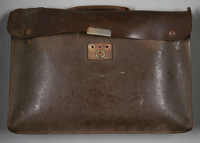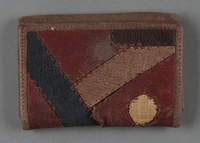Overview
- Brief Narrative
- Brown leather wallet with a strap brought with Paul Zilczer when he left Budapest, Hungary, for the United States, in May 1939. Paul, a physicist, and his wife Margit lived in Budapest, when in 1938, the fascist Hungarian government passed laws restricting the rights of Jews. In 1939, Paul and Margit both traveled to England. On May 17, Paul sailed to New York City where he lived with his cousin Emil and his family. Margit returned to Budapest. In November 1940, Hungary entered World War II as a German ally. In March 1944, Germany invaded Hungary to ensure Hungary's continued involvement with the war effort and their cooperation in the deportation of all Hungarian Jews to concentration camps. Margit was deported to Ravensbrück concentration camp in Germany and killed in November 1944.
- Date
-
emigration:
1939 May 17-1939 May 24
- Geography
-
received:
Budapest (Hungary)
- Credit Line
- United States Holocaust Memorial Museum Collection, Gift of Janet Zilczer and Judith Zilczer
- Contributor
-
Subject:
Paul Zilczer
- Biography
-
Paul Zilczer was born on August 30, 1908, in Budapest, Hungary, to a Jewish couple. He graduated from college and worked as a physicist. Paul married Margit Gelyi, a young Jewish woman, and the couple settled in Budapest. Margit was born on June 19, 1907, in Gyor, Hungary, to Tibor and Vilma Winkler Gelyi.
During the 1930’s, Hungary was an ally of Nazi Germany, and in 1938, Hungary’s fascist regime adopted anti-Jewish race laws based on Germany’s Nuremberg Laws. In 1939, the Hungarian government established a forced-labor service for able-bodied Jewish men of military age. Paul and Margit travelled to England in 1939. On May 17, Paul boarded the S.S. Manhattan in Southampton, England, and sailed to New York City, where he lived with his cousin Emil and his family. Margit travelled to several places in Europe, including London, England, and Paris, France, before returning to Budapest.
In November 1940, Hungary entered World War II as part of the Axis alliance. In March 1944, Germany invaded Hungary to ensure Hungary's continued involvement with the war effort and their cooperation in the deportation of all Hungarian Jews to concentration camps. On January 18, 1945, the Soviet Army liberated Budapest. The war in Europe ended on May 7, 1945. In 1946, Paul learned that Margit, 37, had been deported to Ravensbrück concentration camp in northern Germany on October 23, 1944, and killed in November. Paul married his second wife, Rose (1917-2011), in approximately 1947. The couple settled in Waterbury, Connecticut, and had two daughters. Paul worked as a research physicist. Paul, age 65, died in November 1973, in Arlington, Virginia.
Physical Details
- Classification
-
Dress Accessories
- Category
-
Carried dress accessories
- Object Type
-
Wallets (lcsh)
- Physical Description
- Rectangular, dark brown, stiff leather bi-fold wallet with rounded corners and a side strap with a pointed end sewn into the right edge. The strap has a snap socket with a snap cap at the end. When the wallet is closed, the snap socket presses into a snap stud on the exterior left side edge. The left half of a folded leather insert, the same shape as the wallet, is sewn along 3 sides to the left side of the wallet, creating a pocket underneath. Whe the insert is unfolded, 2 full length interior billfold pockets extend horizontally across the width. To close the insert, a snap stud on the left edge is pressed into a snap socket and cap on the right edge. The snaps are silver-colored metal with impressed maker's marks and brown painted caps. The wallet is worn and discolored from use.
- Dimensions
- overall: Height: 3.500 inches (8.89 cm) | Width: 3.250 inches (8.255 cm) | Depth: 0.500 inches (1.27 cm)
- Materials
- overall : leather, metal, cloth, paint
Rights & Restrictions
- Conditions on Access
- No restrictions on access
- Conditions on Use
- No restrictions on use
Keywords & Subjects
Administrative Notes
- Legal Status
- Permanent Collection
- Provenance
- The wallet was donated to the United States Holocaust Memorial Museum in 2013 by Janet Zilczer and Judith Zilczer, the daughters of Paul Zilczer.
- Funding Note
- The cataloging of this artifact has been supported by a grant from the Conference on Jewish Material Claims Against Germany.
- Record last modified:
- 2022-08-15 10:43:44
- This page:
- https://collections.ushmm.org/search/catalog/irn61194
Download & Licensing
In-Person Research
- By Appointment
- Request 21 Days in Advance of Visit
- Plan a Research Visit
- Request to See This Object
Contact Us
Also in Paul Zilczer family collection
The collection consists of a briefcase, pouch, wallets, correspondence, documents, and photographs relating to the experiences of Paul Zilczer, his wife Margit Gelyi Zilczer, and their families in Hungary before and during the Holocaust and of Paul Zilczer's experiences after his immigration to the United States in 1939.
Date: approximately 1907-1944

Dark brown leather briefcase brought to the US by a Jewish Hungarian refugee
Object
Brown leather briefcase brought with Paul Zilczer when he left Budapest, Hungary, for the United States, in May 1939. Paul, a physicist, and his wife Margit lived in Budapest, when in 1938, the fascist Hungarian government passed laws restricting the rights of Jews. In 1939, Paul and Margit both traveled to England. On May 17, Paul sailed to New York City where he lived with his cousin Emil and his family. Margit returned to Budapest. In November 1940, Hungary entered World War II as a German ally. In March 1944, Germany invaded Hungary to ensure Hungary's continued involvement with the war effort and their cooperation in the deportation of all Hungarian Jews to concentration camps. Margit was deported to Ravensbrück concentration camp in Germany and killed in November 1944.

Patchwork leather wallet brought to the US by a Jewish Hungarian refugee
Object
Patchwork leather wallet brought with Paul Zilczer when he left Budapest, Hungary, for the United States, in May 1939. Paul, a physicist, and his wife Margit lived in Budapest, when in 1938, the fascist Hungarian government passed laws restricting the rights of Jews. In 1939, Paul and Margit both traveled to England. On May 17, Paul sailed to New York City where he lived with his cousin Emil and his family. Margit returned to Budapest. In November 1940, Hungary entered World War II as a German ally. In March 1944, Germany invaded Hungary to ensure Hungary's continued involvement with the war effort and their cooperation in the deportation of all Hungarian Jews to concentration camps. Margit was deported to Ravensbrück concentration camp in Germany and killed in November 1944.
Zilczer family papers
Document
Contains correspondence, school records, photographs, immigration documents, notebooks, calendar, and related material, mostly concerning Pal (Paul) Zilczer of Szeged and Budapest, Hungary, and his first wife, Margit (Gélyi) Zilczer family. Photographs include dated inscriptions (August 1938-March 1941). Correspondence includes three letters, one written 13 November 1936, from Teréz (Rézi) Strauss Elbert and Zseni Strauss Zilczer (in Budapest) to Pál (Paul) and Margit Zilczer (in Szeged); the other letters dated 29 April and 1 May 1939, from Margit (Maxi) Zilczer (in Surrey, England) to Pál Zilczer (c/o Teréz Strauss Elbert [Mrs. David Elbert], in Budapest). Also includes a 1941 Holland-America Line sponsorship (affidavit) form, completed but not submitted.
Brown leather wallet brought to the US by a Jewish Hungarian refugee
Object
Brown leather wallet brought with Paul Zilczer when he left Budapest, Hungary, for the United States, in May 1939. Paul, a physicist, and his wife Margit lived in Budapest, when in 1938, the fascist Hungarian government passed laws restricting the rights of Jews. In 1939, Paul and Margit both traveled to England. On May 17, Paul sailed to New York City where he lived with his cousin Emil and his family. Margit returned to Budapest. In November 1940, Hungary entered World War II as a German ally. In March 1944, Germany invaded Hungary to ensure Hungary's continued involvement with the war effort and their cooperation in the deportation of all Hungarian Jews to concentration camps. Margit was deported to Ravensbrück concentration camp in Germany and killed in November 1944.
Brown leather pouch brought with a Jewish Hungarian refugee
Object
Brown leather pouch brought with Paul Zilczer when he left Budapest, Hungary, for the United States, in May 1939. Paul, a physicist, and his wife Margit lived in Budapest, when in 1938, the fascist Hungarian government passed laws restricting the rights of Jews. In 1939, Paul and Margit both traveled to England. On May 17, Paul sailed to New York City where he lived with his cousin Emil and his family. Margit returned to Budapest. In November 1940, Hungary entered World War II as a German ally. In March 1944, Germany invaded Hungary to ensure Hungary's continued involvement with the war effort and their cooperation in the deportation of all Hungarian Jews to concentration camps. Margit was deported to Ravensbrück concentration camp in Germany and killed in November 1944.



